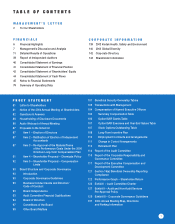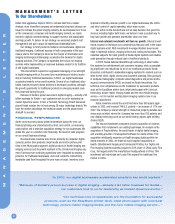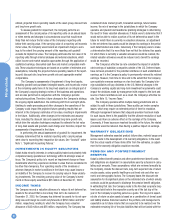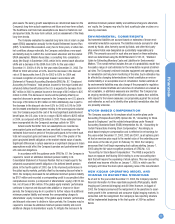Kodak 2003 Annual Report Download - page 8
Download and view the complete annual report
Please find page 8 of the 2003 Kodak annual report below. You can navigate through the pages in the report by either clicking on the pages listed below, or by using the keyword search tool below to find specific information within the annual report.
Financials
8
utilized, projected future operating results of the asset group, discount rate
and long-term growth rate.
To assess goodwill for impairment, the Company performs an
assessment of the carrying value of its reporting units on an annual basis
or when events and changes in circumstances occur that would more
likely than not reduce the fair value of the Company’s reporting units
below their carrying value. If the carrying value of a reporting unit exceeds
its fair value, the Company would record an impairment charge to earn-
ings to the extent the carrying amount of the reporting unit goodwill
exceeds its implied fair value. The Company estimates the fair value of its
reporting units through internal analyses and external valuations, which
utilize income and market valuation approaches through the application of
capitalized earnings, discounted cash flow and market comparable meth-
ods. These valuation techniques are based on a number of estimates and
assumptions, including the projected future operating results of the report-
ing unit, discount rate, long-term growth rate and appropriate market
comparables.
The Company’s assessments of impairment of long-lived assets,
including goodwill and purchased intangible assets, and its periodic review
of the remaining useful lives of its long-lived assets are an integral part of
the Company’s ongoing strategic review of the business and operations,
and are also performed in conjunction with the Company’s periodic
restructuring actions. Therefore, future changes in the Company’s strategy,
the ongoing digital substitution, the continuing shift from overnight photo-
finishing to onsite processing and other changes in the operations of the
Company could impact the projected future operating results that are
inherent in the Company’s estimates of fair value, resulting in impairments
in the future. Additionally, other changes in the estimates and assump-
tions, including the discount rate and expected long-term growth rate,
which drive the valuation techniques employed to estimate the fair value
of long-lived assets and goodwill could change and, therefore, impact the
assessments of impairment in the future.
In performing the annual assessment of goodwill for impairment, the
Company determined that no material reporting units’ carrying values
were close to exceeding their respective fair values. See “Goodwill” under
Note 1, “Significant Accounting Policies.”
INVESTMENTS IN EQUITY SECURITIES
Kodak holds minority interests in certain publicly traded and privately held
companies having operations or technology within its strategic areas of
focus. The Company’s policy is to record an impairment charge on these
investments when they experience declines in value that are considered to
be other-than-temporary. Poor operating results of the investees or
adverse changes in market conditions in the future may cause losses or
an inability of the Company to recover its carrying value in these underly-
ing investments. The remaining carrying value of the Company’s invest-
ments in these equity securities is $25 million at December 31, 2003.
INCOME TAXES
The Company records a valuation allowance to reduce its net deferred tax
assets to the amount that is more likely than not to be realized. At
December 31, 2003, the Company has deferred tax assets for its net oper-
ating loss and foreign tax credit carryforwards of $258 million and $137
million, respectively, relating to which the Company has a valuation
allowance of $45 million and $56 million, respectively. The Company has
considered future market growth, forecasted earnings, future taxable
income, the mix of earnings in the jurisdictions in which the Company
operates, and prudent and feasible tax planning strategies in determining
the need for these valuation allowances. If Kodak were to determine that it
would not be able to realize a portion of its net deferred tax asset in the
future for which there is currently no valuation allowance, an adjustment
to the net deferred tax assets would be charged to earnings in the period
such determination was made. Conversely, if the Company were to make
a determination that it is more likely than not that the deferred tax assets
for which there is currently a valuation allowance would be realized, the
related valuation allowance would be reduced and a benefit to earnings
would be recorded.
The Company’s effective tax rate considers the impact of undistrib-
uted earnings of subsidiary companies outside of the U.S. Deferred taxes
have not been provided for the potential remittance of such undistributed
earnings, as it is the Company’s policy to permanently reinvest its retained
earnings. However, from time to time and to the extent that the Company
can repatriate overseas earnings on a tax-free basis, the Company’s for-
eign subsidiaries will pay dividends to the U.S. Material changes in the
Company’s working capital and long-term investment requirements could
impact the decisions made by management with respect to the level and
source of future remittances and, as a result, the Company’s effective tax
rate. See Note 15, “Income Taxes.”
The Company operates within multiple taxing jurisdictions and is
subject to audit in these jurisdictions. These audits can involve complex
issues, which may require an extended period of time for resolution.
Although management believes that adequate provision has been made
for such issues, there is the possibility that the ultimate resolution of such
issues could have an adverse effect on the earnings of the Company.
Conversely, if these issues are resolved favorably in the future, the related
provisions would be reduced, thus having a positive impact on earnings.
WARRANTY OBLIGATIONS
Management estimates expected product failure rates, material usage and
service costs in the development of its warranty obligations. In the event
that the actual results of these items differ from the estimates, an adjust-
ment to the warranty obligation would be recorded.
PENSION AND POSTRETIREMENT
BENEFITS
Kodak’s defined benefit pension and other postretirement benefit costs
and obligations are dependent on assumptions used by actuaries in calcu-
lating such amounts. These assumptions, which are reviewed annually by
the Company, include the discount rate, long-term expected rate of return
on plan assets, salary growth, healthcare cost trend rate and other eco-
nomic and demographic factors. The Company bases the discount rate
assumption for its significant plans on the estimated rate at which annuity
contracts could be purchased to discharge the pension benefit obligation.
In estimating that rate, the Company looks to the AA-rated corporate long-
term bond yield rate in the respective country as of the last day of the
year in the Company’s reporting period as a guide. The long-term expect-
ed rate of return on plan assets is based on a combination of formal asset
and liability studies, historical results of the portfolio, and management’s
expectation as to future returns that are expected to be realized over the
estimated remaining life of the plan liabilities that will be funded with the





















